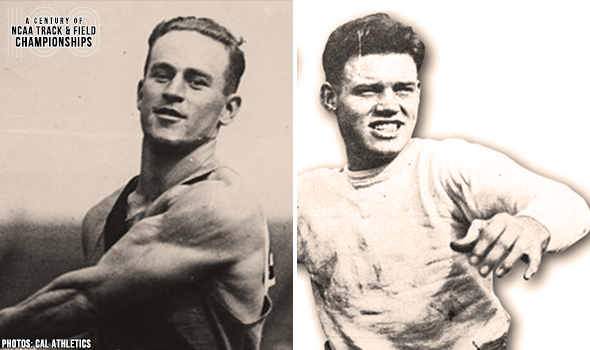
Merchant, Muller Led Cal’s Field Day In 1922
Cal had a literal field day in 1922.
As great as the inaugural NCAA Outdoor Track & Field Championships were in 1921, the second event was bigger — and arguably, even better.
The 1922 edition had something the 1921 version didn’t – the California Golden Bears, hot off a second-straight win at the powerful IC4A Championships (Cal was the first non-East Coast program to win the meet in 1921).
The Bears scored all but three of their then-record 281⁄18 points in all seven field events (The triple jump was not yet on the program and would only be held five times between 1932 and 1956, before becoming an annual event in 1959). They were led by a pair of three-event scorers – both in combinations that displayed exceptional and unusual athletic ability.
Jack Merchant – a 1920 Olympian in the long jump – won NCAA titles in the shot and hammer, the latter being the event in which he would compete at the 1924 Olympics. He added points in the long jump, placing fourth when all field events were contested on the same day.
Merchant, who was a graduate of the same Marshfield High School in Coos Bay, Oregon (formerly known as Marshfield, Oregon) as eventual distance legend Steve Prefontaine, scored a team-high 11 points at the 1922 NCAA meet. To wit, scoring was on a 5-3-2-1-½ system back then; Merchant’s performance would be worth 25 points on the current scoring system, a meet total that wouldn’t be surpassed until Jesse Owens racked up 40 in back-to-back years in 1935 and 1936.
Cal’s other point-scoring machine was Harold “Brick” Muller (He was commonly called “Brick” because of the red color of his hair). Born near the Oregon border in Dunsmuir, California, Muller grew up in San Diego and went to Cal as a football player (He was MVP for the Bears’ “Wonder Team” in their 28-0 win over Ohio State in the 1921 Rose Bowl).
Muller was as versatile as Merchant in track & field — and actually more accomplished internationally, earning the silver medal at the 1920 Olympics in the high jump. In the 1922 NCAA meet, Muller’s best finish was in the long jump where he took second over Merchant’s aforementioned fourth. Muller also added points in the high jump (third) and discus (fourth).
After playing and coaching football – notably at the same time for the Los Angeles Buccaneers in their only season in the NFL in 1926 – Muller would also go to a second Olympics, but not until 1956 as head team physician.
Cal nearly won that 1922 NCAA meet just with Merchant and Muller. After all, runner-up Penn State’s 19½ points were the only total higher than the 17 combined points from the Bear duo. Cal also had five more scorers in the meet to turn away the Nittany Lions: Allen Norris tied for first in the pole vault; Harry McDonald finished second in the 440 as the team’s only scorer on the track; Jack Witter took third in the shot; Sandy Sorrenti was third in the javelin; Ted Treyer ended up in a nine-way tie for fifth in the high jump, which helps explain the fractions.
The NCAA and collegiate track & field will mark a momentous milestone in the spring of 2021 -- the 100th anniversary of the NCAA Championships and with that, the NCAA Track & Field Championships. In June 1921, the University of Chicago hosted the first track & field championships in NCAA history.
This point can’t be emphasized enough: Not only was the event the first for NCAA track & field, but the first championships for any sport under the sponsorship of the NCAA.
To celebrate, over each of the next 365 days, the U.S. Track & Field and Cross Country Coaches Association (USTFCCCA) will celebrate moments, student-athletes, and coaches that have made a century’s worth of championships special. From humble beginnings to important historical milestones to the modern-day, collegiate track & field has evolved with the American society.
The 2021 edition of the NCAA Division I Outdoor Track & Field Championships begin with preliminary round action on May 27-29 in Jacksonville, Fla., and College Station, Texas. The championships final site and culmination of the celebration is slated for June 9-12, 2021 at the newly rebuilt Hayward Field in Eugene, Ore.
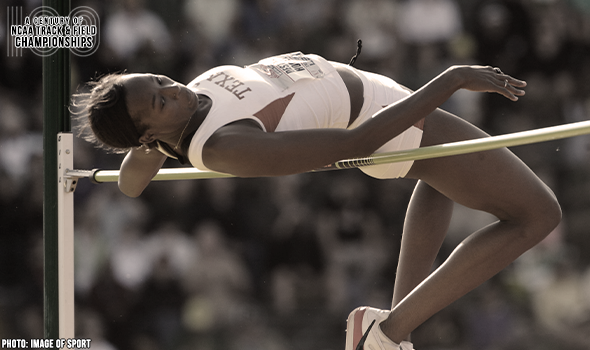
Texas’ Hooker High Jumped To NCAA Glory
Destinee Hooker won three career high jump titles at the NCAA DI Outdoor T&F Championships, including a massive victory in 2009 by more than two inches.
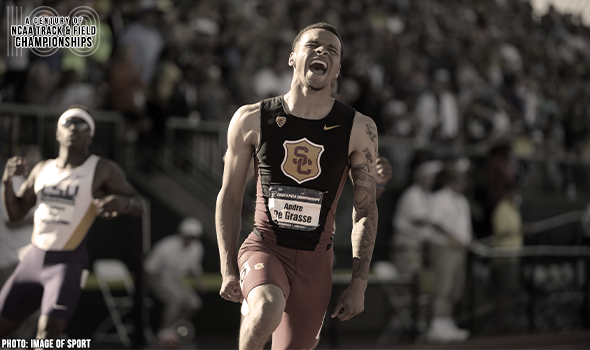
De Grasse Sprinted To Otherworldly Double
Andre De Grasse completed the 100-200 double at the 2015 NCAA DI Outdoor T&F Championships with scorching times: 9.75 (+2.7) in the 100; 19.58 (+2.4) in the 200.
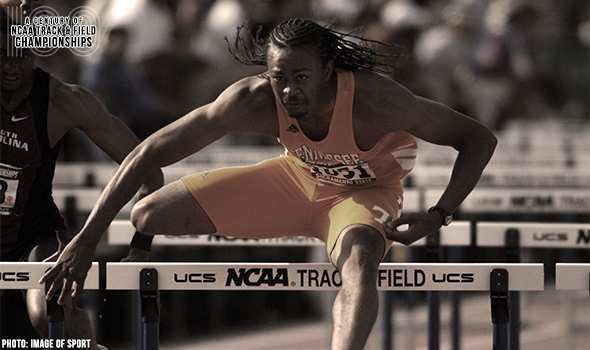
Merritt Broke Long-Standing 110H MR In 2006
Aries Merritt broke a 28-year-old meet record in the 110H when he won the crown at the 2006 NCAA DI Outdoor T&F Championships in 13.21.
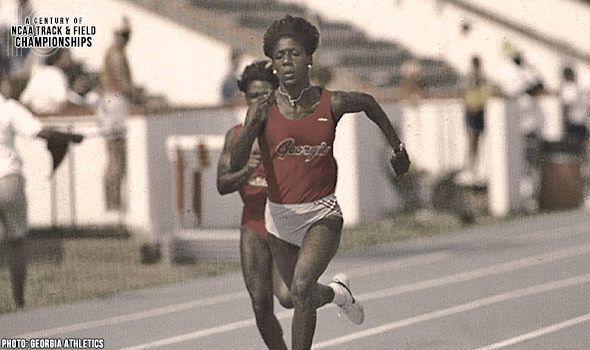
UGA’s Torrence Made NCAA History With Double
Gwen Torrence completed the 100-200 double at the 1987 NCAA DI Outdoor T&F Championships. Torrence was also the first woman to finish top-8 four times in the 100.
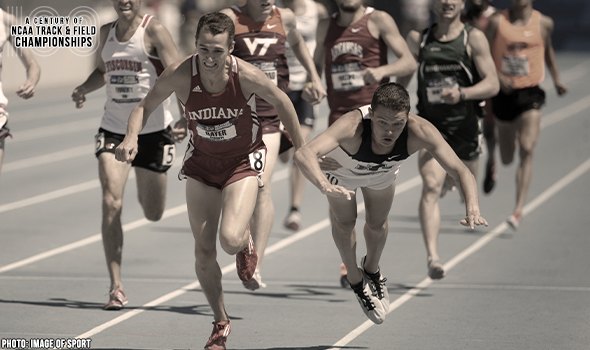
Bayer Gave It His All For NCAA 1500 Title
Andrew Bayer won the 1500 at the 2012 NCAA DI Outdoor Track & Field Championships in one of the closest finishes in meet history – 0.01 seconds.

Tipton Led 1-2-3 Oregon Finish In 1964 JT
Les Tipton led the first podium sweep of any event in the history of the NCAA Outdoor T&F Championships. Tipton and his Oregon teammates went 1-2-3 in the 1964 javelin.

K-State’s Jones Captured Heptathlon Crown In 2015
Akela Jones won the heptathlon at the 2015 NCAA DI Outdoor T&F Championships with 6371 points. That is the fourth-best score in both collegiate history & meet history.

Same Athletes, Same Result For LSU At NCAAs
The LSU foursome of Bennie Brazell, Pete Coley, Robert Parham, Kelly Willie swept the 4×100 & 4×400 crowns at the 2003 NCAA DI Outdoor T&F Championships.

Martin Won Distance Titles For Two Programs
Francis (Frank) Martin made history twice in the NCAA Outdoor Track & Field Championships.

FSU’s Williams Soared To Jumps Double In 2009
Kim Williams swept the horizontal jumps at the 2009 NCAA DI Outdoor T&F Championships. Williams was particularly dominant in the TJ, winning at 14.38m (47-2¼) & by nearly 2 feet.

